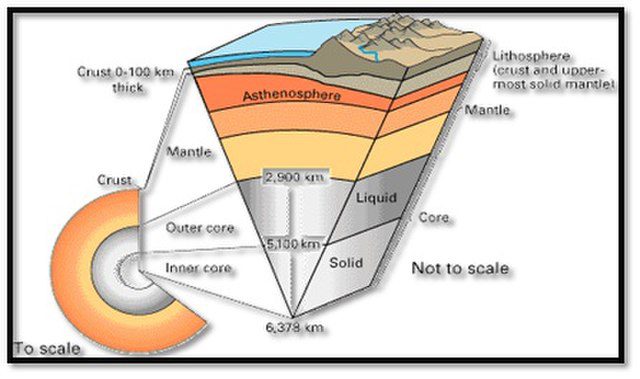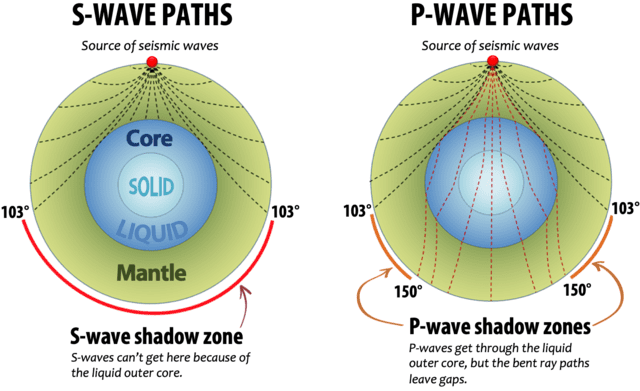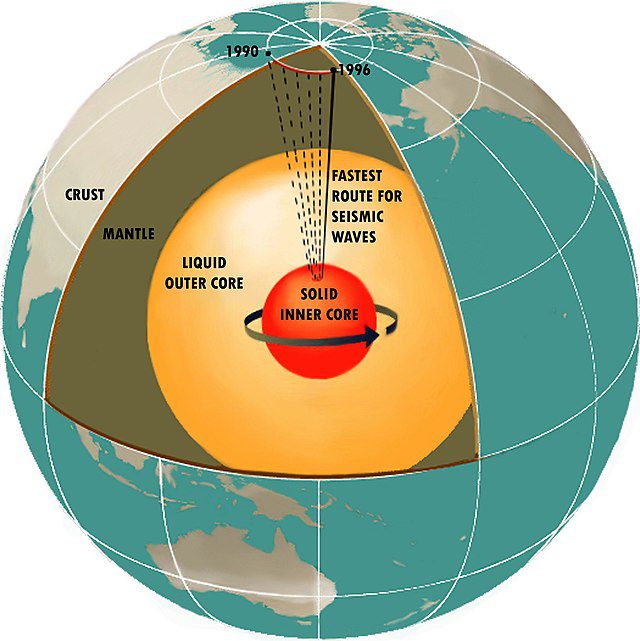
Dynamo Theory – Outer core convection and magnetic field generation-by Andrew Z. Colvin-Wikimedia Commons
Top 10 Facts About The Earth’s Outer Core
When someone is curious about what lies beneath the water, they dive further into the ocean. But what about what lies beneath the earth’s surface? Research relies heavily on types of equipment that can detect what’s underneath since no one can travel far inside the Earth. Earth comprises four separate layers, beginning at the center which are the inner core, outer core, mantle, and crust in order of their depth. At any point, no one has been able to visit these layers except for the crust. To be precise, the deepest hole ever dug by humans was 12 kilometers (7.6 miles) long. The outer core lies the third on the earth’s layers and it’s composed of iron and nickel but in liquid form. It is located about 5,150 km (3,200 mi) beneath the Earth’s surface at the inner core boundary. This particular core is in charge of the earth’s magnetic field which shields the earth from hazardous particles emitted by the sun. Here are the top facts about the Earth’s outer core.
Read also; 15 Fun Facts about Earth
1. The outer core is the second innermost layer of the Earth, situated between the inner core and the mantle

Interior of the Earth-by Nasrianto-Wikimedia Commons
The Earth’s outer core is in liquid form with a layer of about 2270 km thick, which is mainly made of iron and nickel and is located between the inner core and the mantle. According to estimates, the outer core lies approximately 2889 kilometers beneath the Earth’s surface and 5,150 kilometers at the inner core boundary from the Earth’s surface.
2. The outer core is primarily made up of liquid iron and nickel
In contrast to the Earth’s inner core, which is solid, the outer core is mostly formed of liquid iron and nickel. Seismology, which reveals that seismic shear waves are not transmitted through the outer core, provides evidence for a fluid outer core. Despite possessing a composition identical to Earth’s solid inner core, the outer core remains liquid because there is insufficient pressure to keep it solid. Iron, nickel, and other heavy metals such as gold make up the core of the earth since they are the heaviest metals and so sunk to the center of the world.
3. The outer core is in charge of the Earth’s magnetic field

Geomagnetic field and magnet analogy-by Quatus-Wikimedia Commons
The outer core is the second innermost layer of the Earth, situated between the inner core and the mantle. It is largely composed of iron and nickel, which are in liquid form because of the lower pressure than that found in the inner core. Temperature, composition, and pressure differences within the outer core lead the fluid to move convectively. Furthermore, the Coriolis force acting on the fluid organizes this motion into rolls that are parallel to the Earth’s spin axis. Each roll generates an electric current, which is the source of its magnetic field. Because both magnetic fields act in the same direction, their combined influence creates the total geomagnetic field, which stretches far into space and shields our planet’s atmosphere from the solar wind.
4. The outer core’s NiFe alloy is extremely heated
The temperature of the outer core is estimated to be around 3,000-4,500 K (2,700-4,200 °C; 4,900-7,600 °F) in its outer area. The temperature then nearly doubles at the boundary between the outer and inner cores, to about 4,000-8,000 K (3,700-7,700 °C; 6,700-14,000 °F). That’s the part that’s as hot as the sun’s surface. At such temperatures, almost everything vaporizes into gas, including metals, diamonds, and even humans.
5. Since the earth’s formation, its outer core was initially molten

Safronov’s model for core formation-by AlexInMetal-Wikimedia Commons
When the Earth first formed 4.5 billion years ago, the whole core was molten. Since then, the Earth has been progressively cooling, losing heat to space. The solid inner core formed when it cooled, and it has been expanding in size ever since. The Earth’s core is not completely molten right now. The inner core is a solid iron sphere, whereas the outer core is molten iron millions of kilometers thick.
Read also; 15 Fun Facts about Earth’s Atmosphere
6. The Earth’s outer core is unreachable for direct sampling
No one has ever drilled to the center of the Earth, nor has anybody ever drilled through the Earth’s crust. Indeed, we know more about space than we do about what lies beneath the Earth’s surface. The majority of core research has been done by monitoring seismic waves, which are the shock waves produced by earthquakes at or near the surface. Seismic body wave velocity and frequency vary with pressure, temperature, and rock composition.
7. The outer core of the Earth is undergoing turbulent convection

Outer core convection rolls-by United States Geological Survey-Wikimedia Commons
As a result of radioactive heating and chemical differentiation, the Earth’s outer core is experiencing turbulent convection. This initiates a process similar to that of a naturally occurring electrical generator, in which convective kinetic energy is converted to electrical and magnetic energy. In essence, the velocity of the electrically conducting iron in the presence of the Earth’s magnetic field causes electric currents to flow. Because the electric currents generate their own magnetic field, the process is self-sustaining as long as there is an energy source sufficient to continue convection.
8. The movement of the Earth’s tectonic plates is aided by the outer core
For decades, scientists have hypothesized that the movement of the Earth’s tectonic plates is mostly driven by the negative buoyancy formed when they cool. Yet, a new study indicates that plate dynamics are strongly influenced by the added force of heat from the Earth’s core. The Earth’s core provides the source of the heat energy needed to form convection currents in the outer core and mantle. The currents are responsible for tectonic plate movements on the Earth.
9. The outer core of the Earth is not entirely made of iron or iron-nickel alloys

Seismic wave travel through Earth-by Karla PanchukSteven Earle-Wikimedia Commons
Because their densities are larger than geophysical measurements of Earth’s outer core density, Earth’s outer core cannot be fully composed of iron or iron-nickel alloy. It has been postulated that light elements with low atomic numbers form part of Earth’s outer core as the only conceivable means to reduce its density. According to recent estimates, the Earth’s outer core is composed of iron with 0 to 0.26 percent hydrogen, 0.2 percent carbon, 0.8 to 5.3 percent oxygen, 0 to 4.0 percent silicon, 1.7 percent sulfur, and 5 percent nickel by weight, and the core-mantle boundary and inner core boundary temperatures range from 4,137 to 4,300 K and 5,400 to 6,300 K, respectively.
Read also; Top 15 Facts About the Solar System
10. The outer core is under immense pressure
Pressure rises in the outer core as a result of the weight of the crust and mantle above. The outer core of the Earth has pressures ranging from 135 to 330 Gigapascals (1.3 to 3.3 million atmospheres) and temperatures ranging from 3,000 to 4,500 Kelvin (2,700 to 4,200 degrees Celsius, or 4,900 to 7,600 degrees Fahrenheit).
We can thank the outer core for Earth’s thriving life. Convection in the outer core maintains the magnetic field, which shields us from harmful solar radiation and keeps our atmosphere intact.
Planning a trip to Paris ? Get ready !
These are Amazon’s best-selling travel products that you may need for coming to Paris.
Bookstore
- The best travel book : Rick Steves – Paris 2023 – Learn more here
- Fodor’s Paris 2024 – Learn more here
Travel Gear
- Venture Pal Lightweight Backpack – Learn more here
- Samsonite Winfield 2 28″ Luggage – Learn more here
- Swig Savvy’s Stainless Steel Insulated Water Bottle – Learn more here
Check Amazon’s best-seller list for the most popular travel accessories. We sometimes read this list just to find out what new travel products people are buying.










